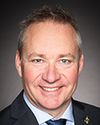Absolutely.
What is your definition of “rural” in the sense of connectivity?
Evidence of meeting #82 for Canadian Heritage in the 44th Parliament, 1st Session. (The original version is on Parliament’s site, as are the minutes.) The winning word was connectivity.
A recording is available from Parliament.
4:50 p.m.
Conservative

Martin Shields Conservative Bow River, AB
Absolutely.
What is your definition of “rural” in the sense of connectivity?
4:50 p.m.
Auditor General, Office of the Auditor General
I think I'll ask Sami to give you that definition. How does that sound?
May 18th, 2023 / 4:50 p.m.
Sami Hannoush Principal, Office of the Auditor General
The definition we used in this project was the definition being used by StatsCan and various federal departments. It defines rural communities as having less than 1,000 inhabitants. “Remote” can also be part of those rural communities, or it can be isolated in a different sense in that they're smaller but are not near adjoining communities that they could potentially piggyback off of for connectivity.
4:50 p.m.
Conservative

Martin Shields Conservative Bow River, AB
Here's a challenge I see, and it's about economics. If we're talking about highly technical agri-industries, they're not located in communities.
When you're talking about connectivity and communities, we have a challenge here. For example, I have people in the agriculture industry running pivots—and when I say the word “pivots”, people sometimes know what I'm talking about—from farms that are high-tech. I met somebody today in a rural ag-producing industry, and they're very technical and very short of...but they're not in a community.
How do we address that issue? You say your definition is about communities, yet if we're talking about economics in our highly technological ag sector, they're not in communities.
4:50 p.m.
Auditor General, Office of the Auditor General
We didn't make up the definition. We're following the definition that Statistics Canada uses, because that's one with data gathered from around the country.
I think that speaks to why we need to be careful as a country when comparing ourselves to others without thinking about household income and other aspects. Our country is geographically vast, and there are many areas with low population, unlike the United States, which is very dense in many areas that it's easier to reach many more individuals with the infrastructure. That's why it's important to really consider the particularities of Canada as the strategy plans its way out.
4:50 p.m.
Conservative

Martin Shields Conservative Bow River, AB
I think that's critical when we're talking about economics. When the government is talking about an increase in productivity in one of our most technologically advanced sectors, agriculture, they don't have that capability of being connected. That's really problematic rurally in the sense of the definition we have.
Moving to another question, you talked about reaching targets. The plan, over the last number of years of reports, has been trying to reach the target of going above the OECD average. Do you have any idea why you think it's going down, in a sense—from 6.4% down to 4.8% of the average?
4:50 p.m.
Auditor General, Office of the Auditor General
I'm sorry. I'm not sure Sami and I know what you're pointing to. Is this within our report or are you reading these OECD statistics from somewhere else?
4:50 p.m.
Conservative

Martin Shields Conservative Bow River, AB
You've talked about what the CRTC is doing in the sense of meeting their targets. Their last few reports said they're trying to achieve above the average OECD targets. You've referred to the OECD and what their targets are. You're not familiar with that, then.
4:50 p.m.
Auditor General, Office of the Auditor General
I'm not sure I know what you're talking about. I referred to the OECD when it came to what a definition of “affordable” should look like.
4:50 p.m.
Conservative

Martin Shields Conservative Bow River, AB
Right. Yes. I just assumed that you knew a lot about the OECD and their targets for Internet service and what Canada—
4:50 p.m.
Auditor General, Office of the Auditor General
I know some of them, but I'm not sure I know the reference you're making. My apologies.
4:50 p.m.
Conservative

The Vice-Chair Conservative Kevin Waugh
We're going to move on, Mr. Shields. Thank you very much. I gave you a little extra.
4:50 p.m.
Auditor General, Office of the Auditor General
Maybe I'll just tell you that we focused on the targets that Canada set itself in its own strategy, not comparing those to any international targets or best practices that the OECD might have.
4:50 p.m.
Conservative
4:50 p.m.
Conservative

The Vice-Chair Conservative Kevin Waugh
Thank you, Ms. Hogan.
We'll move on to the Liberal Party for five minutes with Tim Louis.
Tim, welcome.
4:50 p.m.
Liberal

Tim Louis Liberal Kitchener—Conestoga, ON
Thank you, Chair.
Thank you to our guests, Auditor General Hogan and Mr. Hannoush.
I want to thank the Office of the Auditor General of Canada for their report on rural and remote connectivity. We appreciate the recommendations and really look forward to continuing the government's work on broadband. We're on our way, well on our way, to surpassing our goal of connecting 98% of Canadians to high-speed Internet by 2026 and 100% of Canadians by 2030.
We heard some numbers earlier. In 2014, I believe it was, only 79% of households had access to high-speed Internet. In Kitchener—Conestoga today, 89.5% of homes have access. That includes a strong agriculture sector. It's something that I think Canadians should be proud of. I talk to people in small communities like Crosshill, Dorking, Hawkesville, Heidelberg, Linwood, Millbank, St. Clements, New Hamburg and Wellesley. These are small communities, and they've received funding to expand high-speed Internet coverage.
Most of these projects are scalable projects for future needs, which is closing the digital divide between urban and rural communities. Earlier we heard about the importance of scalability. Most of these new projects, 80%, are scalable. As I explain it to my constituents, if you're going to be building a road, you leave room for extra lanes. That's what about 80% of these projects are doing for future growth.
We know that there's more to do and we remain committed to doing that work. That's why I think it's important that you're here. Your report is so important. The governments of Canada and Ontario, not that long ago, announced funding of almost $12 million for broadband infrastructure in the Waterloo region, which connects thousands of homes and businesses, mostly in my riding of Kitchener—Conestoga.
The federal government signed partnerships with, I believe, six of the provincial governments, Ontario being one of them. Can you tell us what your assessment is of the effectiveness of these partnerships and how they're helping the government achieve its national connectivity goals? What lessons can your report share about the importance of putting partisanship aside and coordinating and working across party lines and across jurisdictional lines for the common goal of helping our rural communities?
4:55 p.m.
Auditor General, Office of the Auditor General
We did look at how the federal government coordinates its efforts with the provinces. We felt it was important to make sure that this coordination was happening so that every dollar spent, whether it be federal or provincial money, would be spent to go further and not just double up on a project.
We found that most of the provinces that had connectivity money or initiatives already had a memorandum of understanding with the federal government and were doing their best to coordinate. We saw that it reduced a lot of administrative burden when it came to accessing funding. However, we can only focus on the delivery of the programs federally. That's where we looked at what the CRTC and Innovation, Science and Economic Development Canada were doing. We found that they were really slow in approving projects. That's contributing to people waiting longer for Internet access.
4:55 p.m.
Liberal

Tim Louis Liberal Kitchener—Conestoga, ON
Thank you.
You used the word “coordinating” a few times. I think that's important.
Recently I hosted a round table with the Minister of Rural Economic Development. We had rural mayors, businesses and other stakeholders discussing the issues that face our small communities, many of which we've heard today in committee. Broadband Internet was one of the major topics, and we said how the federal government needed to work together with the provinces, territories, municipalities, indigenous communities and Internet service providers.
Your report noted that the federal government is not solely responsible for improving connectivity. Do you think provincial and territorial governments and the private sector are doing their part with cost-sharing in working toward these goals? What ways can they further step up, and how can that be incentivized?
4:55 p.m.
Auditor General, Office of the Auditor General
I think that's a difficult question for me to ask when I really can't look at the books of provinces, private corporations and service providers. What I can look at is what the federal government does. I can only hold them accountable for the commitments they've made and whether they're achieving them or not.
I was pleased to see coordination. That's a step in the right direction, but for elements like the tax credit that's available, ISED doesn't know whether or not people are using it and accessing it.
There are still opportunities to further advance that coordination and collaboration. I would come back to the main point that the two main departments in our report need to really improve how they review, approve and deliver funding to service providers, because it's that concrete action that will actually improve connectivity across the country.
4:55 p.m.
Conservative

The Vice-Chair Conservative Kevin Waugh
Thank you, Tim. You're out of time.
We'll go now to the Bloc for two and a half minutes.
Go ahead, Mr. Champoux.
4:55 p.m.
Bloc

Martin Champoux Bloc Drummond, QC
You're giving me two and a half minutes, but I know how generous you are, Mr. Chair.
Ms. Hogan, your answers are extremely interesting. I also find it very interesting to learn a bit more about the way you work.
4:55 p.m.
Conservative

The Vice-Chair Conservative Kevin Waugh
We're having interpretation problems. We'll give you the full two and a half and we'll start over.
Go ahead.
4:55 p.m.
Bloc

Martin Champoux Bloc Drummond, QC
Ms. Hogan, you heard what was said.
In a previous answer, you said you work with the tools at your disposal. In other words, the data that Statistics Canada provides to you are based on criteria it establishes, such as what constitutes a rural region.
When you conduct your audits, do you ever think that you're not really working with the right tools? Can you make recommendations to adapt the tools with which you have to work, such as the criteria from Statistics Canada?